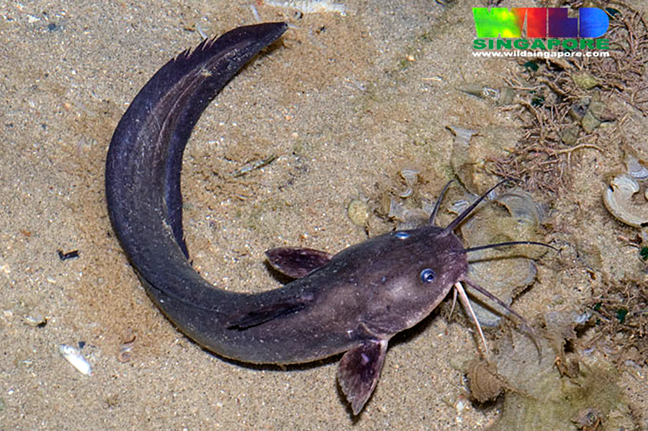Eel Catfish, Plotosus canius Hamilton-Buchanan 1822
Other Names: Black Eeltail Catfish, Canine Catfish-eel, Gray Eel-catfish

An Eel Catfish, Plotosus canius, in Singapore. Source: Ria Tan / Flickr: EOL Images. License: CC BY Attribution-Noncommercial-ShareAlike
Summary:
A large dusky-brown eel-tail catfish with a black tip on the dorsal fin, a pale belly, long nostril barbels that extend beyond the eyes, and continuous dorsal, caudal and anal fins.
The serrated dorsal and pectoral-fin spines are highly venomous and can inflict a very painful wound.
The serrated dorsal and pectoral-fin spines are highly venomous and can inflict a very painful wound.
Cite this page as:
Bray, D.J. 2020, Plotosus canius in Fishes of Australia, accessed 27 Jun 2025, https://fishesofaustralia.net.au/Home/species/3309
Eel Catfish, Plotosus canius Hamilton-Buchanan 1822
More Info
|
Distribution |
Admiralty Gulf, Western Australia, to the Tomkinson River, Northern Territory. Elsewhere the species occurs in the tropical, Indo-west Pacific: west coast of India east to the Philippines and New Guinea, south to northern Australia. Inhabits muddy areas in estuaries, lagoons, and inshore waters, including the lower parts of rivers, mangroves and seagrass beds. Juveniles may form dense schools. |
|
Features |
Dorsal fin I,4-5; Pectoral fin I,10-11; Caudal-dorsal-anal fin 240-270. Body elongated, anteriorly depressed, posteriorly compressed; mouth transverse, upper lip longer; snout rounded. Barbels in four pairs; maxillary barbels as long as nasal and mandibular barbels and reach beyond gill-opening. Dorsal spine and pelvic spines serrated on both edges, venomous; second dorsal and anal fins confluent with caudal fin. |
|
Feeding |
Feeds on crustaceans, molluscs and fishes. |
|
Remarks |
The stout, serrated dorsal and pectoral-fin spines are venomous and may inflict extremely painful wounds. |
|
Similar Species |
Can be distinguished from the Striped Catfish, Plotosus lineatus, by the length of the nasal barbels that extend well beyond the eyes. |
|
Species Citation |
Plotosus canius Hamilton 1822. An account of the fishes found in the River Ganges and its branches: 142, 374, pl. 15 (fig.44). Type locality: southern Bengal, India. |
|
Author |
Bray, D.J. 2020 |
|
Resources |
Eel Catfish, Plotosus canius Hamilton-Buchanan 1822
References
Burgess, W.E. 1989. An Atlas of Freshwater and Marine Catfishes — a preliminary survey of the Siluriformes. Neptune City, New Jersey : T.F.H. Publications 783 pp.
Ferraris, C. 1999. Family Plotosidae. pp. 1880-1883 in Carpenter, K.E. & Niem, V.H. (eds). The Living Marine Resources of the Western Central Pacific. FAO Species Identification Guide for Fisheries Purposes. Rome : FAO Vol. 3 pp. 1397-2068.
Gomon, J.R. & Taylor, W.R. 1982. Plotosus nkunga, a new species of catfish from South Africa, with a redescription of Plotosus limbatus Valenciennes and key to the species of Plotosus (Siluriformes : Plotosidae). Special Publication of the J.L.B. Smith Institute of Ichthyology Rhodes University 22: 1-16 figs 1-2 pls 1-2
Hamilton, F. 1822. An account of the fishes found in the River Ganges and its branches. Edinburgh : Archibald Constable 405 pp., pls 1-39. See ref at BHL
Hossain, M.Y. & Alam, M.J. 2015. Threatened fishes of the world: Plotosus canius Hamilton, 1822 (Siluriformes: Plotosidae). Croatian Journal of Fisheries 73(1): 35–36 http://dx.doi.org/10.14798/73.1.778
Kuiter, R.H. & Tonozuka, T. 2001. Pictorial guide to Indonesian reef fishes. Part 1. Eels - Snappers, Muraenidae - Lutjanidae. Australia : Zoonetics pp. 1-302.
Larson, H.K., Williams, R.S. & Hammer, M.P. 2013. An annotated checklist of the fishes of the Northern Territory, Australia. Zootaxa 3696(1): 1-293








